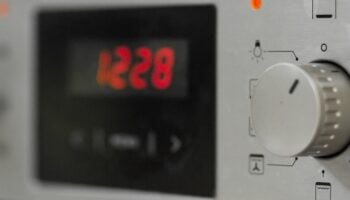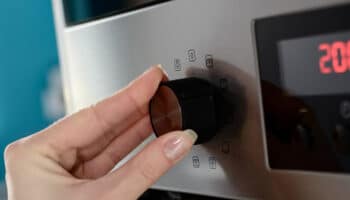We've independently reviewed this article to make sure it's as accurate as we can make it.
To find out more about our article creation and review process, check out our editorial guidelines.
Is your oven leaking brown liquid?
Leaking ovens are quite a common issue, and thankfully there are some simple solutions to stop the problem quickly.
An oven leaking grease is typically just caused by a grease buildup. Your oven may just need a good clean (easier than you think!). If you clean regularly, it may be coming from an area you’ve missed.
In this article I’ll walk you through how to fully investigate and fix your oven’s grease problem.
Without scrubbing yourself crazy!
If that sounds good, then let’s dive in.
Why trust us? This article was written by Craig Anderson and James Blackford.
Craig has helped thousands of other homeowners repair their appliances since 2016.
James is one of our resident appliance experts with over 16 years of experience. He currently works as a Master Technician for SquareTrade, and runs his own appliance repair business.
How to Fix Oven Grease Spill Issues
Having your oven leaking brown liquid or grease is very inconvenient. Apart from the unsightly appearance, grease makes it difficult to cook, and when you cook, the food is not properly done or contains an unsavory smoky taste and color.
The grease will also stain your cooking utensils and clothes when you accidentally touch them. Luckily, there are different ways to clean your oven grease:
#1 Use a Degreaser
If your oven is leaking brown liquid, I recommend using a degreaser and cleaning it.
To degrease your oven, my usual advice to get started is to turn off the power supply to avoid any electrical hazards. If you recently used the oven, please wait for it to cool down completely.
Then, you’ll need to:
- Remove any foreign appliance from the oven. Foreign here means anything that is not part of the oven, such as bakeware, oven racks, trays, and other accessories that usually aid in the cooking process but aren’t part of the oven. Removing foreign objects will make focusing on the appliance’s internal parts easier.
- Scrape off all the oil and grease from the sidewalls and bottom of the oven using a plastic spatula or another flat object. You can also remove the hidden bake tray if it’s removable and clean it on its own since it’s usually the most affected part of the oven.
- Use blotting paper. Blotting paper will help you bloat out any other remaining grease and oil traces inside your appliance. Don’t forget to read the manufacturer’s manual about the dos and don’ts of cleaning an oven and the right cleaning products.
- Get the required degreasing agent and spray it on the sidewalls, racks, and the hidden bake tray to eliminate the grease stains that the first two cleaning processes failed.
- Leave some time for the cleaning solution to completely cut out the grease marks and dissolve the oil stains. Then, scrub with a plastic scouring ball. Wipe the surfaces with a clean paper cloth to remove the liberated grease stains.
- Dilute a mild detergent in water and wet a paper towel in the solution. You can also use other microfiber clothes suitable for your oven as stipulated by the manufacturer. Wipe the oven bottom with the paper towel and wash off the degreaser. Pick a clean paper towel and clean the greasy surfaces further.
- Remove the oven door: Refer to the owner’s manual to learn how to remove the door via its hinges. Once the door is removed, clean the area thoroughly and let it dry before reattaching the door.
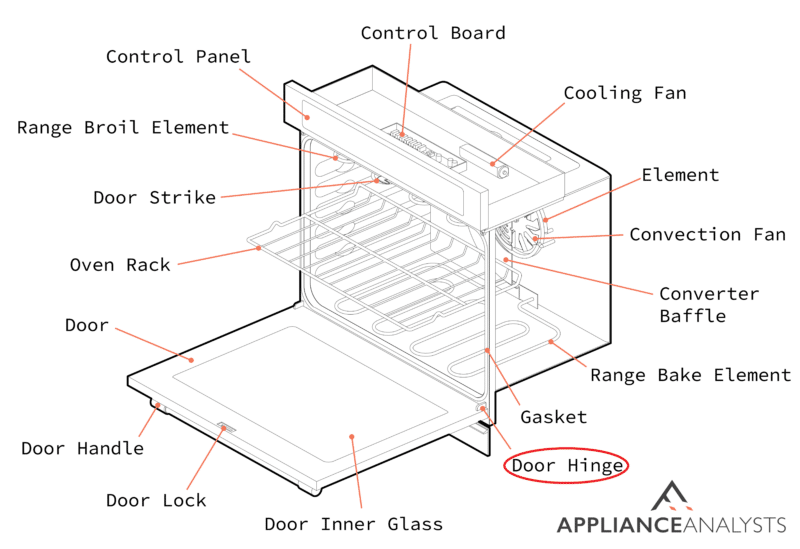
If you can’t find your owner’s manual, please refer to our free resources below.
Once done cleaning, leave the door open for thirty minutes to one hour to let the accumulated moisture and odor escape.
#2 Use Baking Soda and Water
If your stove is still leaking a brown liquid or grease and you’re looking for an eco-friendly cleaner, I recommend using baking soda. Baking soda is super convenient; it can be found at home or purchased from your local supermarket.
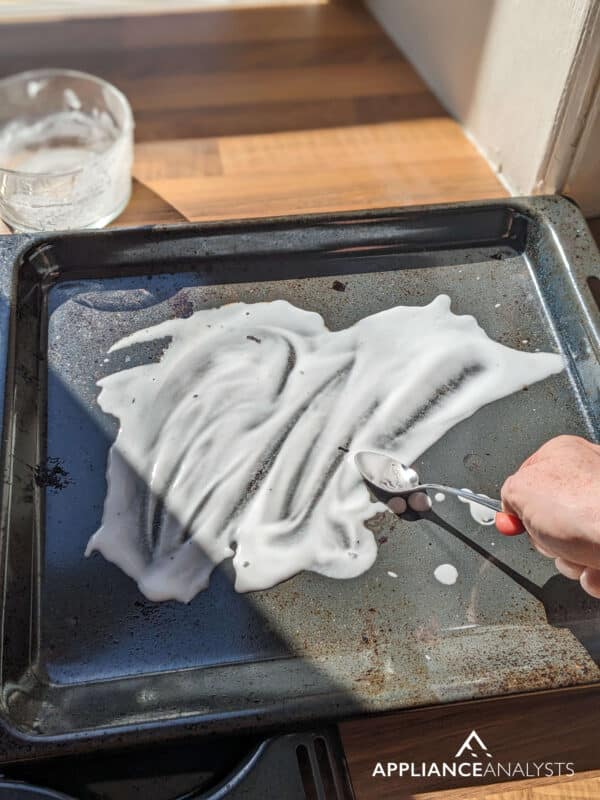
Here’s how to use baking soda to clean your oven:
- Put a cupful of baking soda in a plastic container and add some water. Stir the mixture slowly until you get some thick paste.
- Scoop a small amount using a soft sponge or a spatula and spread a thin, even layer inside the sidewall, rack, oven bottom, or any other surface with grease stains. You can add an extra layer where the grease spots look heavier than in the other places. However, I strongly advise against applying the baking soda mixture on internal fans and heating elements because you can incur hefty repair bills when they get damaged.
- Close the appliance latch and let the baking soda mixture act on the stains for several hours. I recommend applying the mixture in the evening so that the cleaning process continues overnight.
- Use a microfiber cloth, a damp rag, or a kitchen sponge to scrub the greasy surfaces thoroughly and remove any traces of food particles or debris. You had better bring some white vinegar along because some grease stains and other tough grime can be difficult to scrub off.
- Rinse the oven. Once done, remove all the stubborn stains, and rinse the oven with clean water. Wet a clean rag or cloth in clean water and use it to wipe the baking soda mixture and grime off your oven’s surface.
Once the oven is sparkling clean and has no visible grease marks, leave the appliance door open to dry or dry it using some clean absorbent paper or cloth.
I find that plugging the oven into the wall and switching it on to the lowest temperature setting can help dry it much quicker. Please ensure that your hands are dry to avoid getting electrocuted.
#3 Clean the Convection Fan
The convection and the cooling fans inside your oven use a little lubricant to function properly. Some of the components’ greasy lubricants can occasionally leak inside the oven.
Here’s how to clean the fans:
- Unplug the oven from the power socket to avoid electric shocks during the process.
- Open the protective cover using a screwdriver. There’s no need to remove the whole fan if only the blades are affected. You can clean blades while they’re still installed.
- Gently clean the blades. You can use a commercial cleaning solution or baking soda and vinegar. It’s not recommended to remove the fan as you can easily damage the blades.
- Allow the blades to dry completely. Dry blades prevent mold growth.
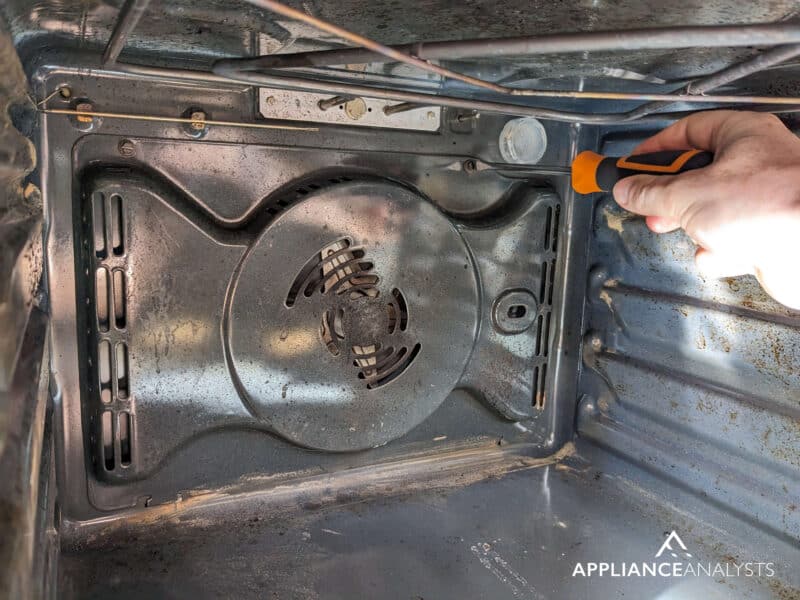
Once you’ve completed the steps above, please dry your hands and switch on the oven. Ensure that the convection fan is running properly.
Signs of Leaking Grease
Now that you know how to effectively clean oven grease and keep your stove from leaking brown liquid, it’s important to watch for the signs of grease buildup.
The first way to tell that your oven is leaking grease. You may see traces of grease leaving the oven once you open the door if the oven is not in operation. Accumulated grease can flow from the hidden bake tray after a cooking session.
The second way to tell that your oven is leaking grease is that it will smoke whenever you turn it on. Don’t ignore any dark or light haze smoke plumes from the oven vent or door.
Smoke is bad news for your household. First, smoke negatively impacts the flavor and quality of baked food. No one likes a smoky dinner!
Secondly, smoke triggers or worsens the symptoms of homeowners with respiratory illnesses and allergies. Smoke can also irritate nearby pets, leading to wild behavior and even increased medical bills, both human and veterinary.
Thirdly, your oven may catch on fire. Fires are uncommon, although dangerous if the oven has been left unattended. Excessive accumulation of grease inside ovens that don’t self-clean can cause a fire. Oven fans may also leak lubricants, although the condition is very rare.
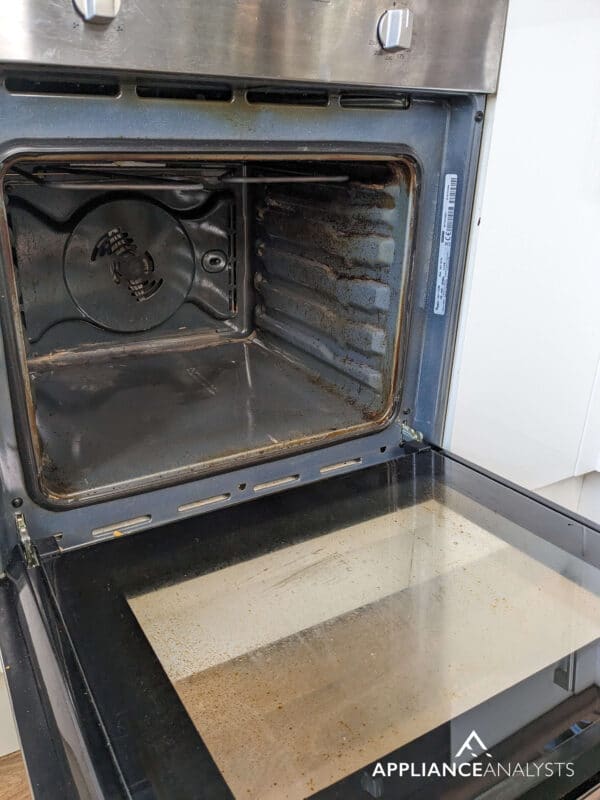
Reasons Why Your Oven Is Leaking Grease
Understanding why your oven is leaking brown liquid or grease can also help you prevent the issue from happening again.
#1 Your Oven Is New
If you observe rising smoke outside the new oven, there’s no cause for alarm. New electric ovens usually contain residual lubrication from the manufacturing process.
Most first-time oven users fail to realize that modern ovens contain an oil-based factory element that will burn and produce smoke once you light up the oven. The substance may also leak inside the carriage box during transit.
To overcome the leaky oil problem, most manufacturers recommend “burning in” your appliance before you begin cooking or baking.
Start by switching the oven off if it is already on. Next, remove any utensils, such as oven pans and pots, that you have placed on the oven racks because the smoke from the procedure can stain them.
Then, shut the oven door and set the oven to bake at the manufacturer’s specified temperature, usually 500 degrees Fahrenheit for 30 to 60 minutes.
The extreme heat will burn out the grease and, therefore, will no longer leak or smoke when baking.
#2 Cooking Activities and Food Types
Most grease is used in ovens and results from your baking activities and behavior. How you bake your pastries, meat, broccoli, or any other food and the nature of the baked food will determine the amount of residual grease inside the oven.
For example, if you broil high-fat foods regularly, say pizzas and fatty steaks, on the exposed oven racks, grease may splatter on the sidewalls and the roof of the appliance. The juicy fat melting from your steak may flow down the rack and accumulate on the hidden bake tray.
Other grease spills are usually due to accidents or inexperience. For example, you may use excessive oils, even with a baking sheet underneath, to cook some food under high temperatures, which may puncture the sheet and cause the oil to leak into the oven cavity.
Other times, you may put excessive oil into your baking trays and spill some more while oiling some types of bread after baking. The accumulated grease will flow out of the door or other available crevices when the oven cools down.
Lastly, no matter how careful you are during cooking, fats, and oils will still melt under high oven temperatures.
Once you’re done cooking and turn off the oven, the low temperatures will cause the oil vapor to condense back to oil and fats, which may line the sidewalls of the oven and begin leaking with time.
Stopping Your Oven From Leaking Grease
That about covers it!
The grease in electric ovens usually emanates from cooking activities and food types. However, new ovens contain some grease from the resultant manufacturing operations, which you should burn out before you start cooking with the new oven.
The above steps will help you fix the issues and stop your oven from leaking brown liquid. If you want, you can opt to buy a modern self-cleaning oven.
Thank you so much for reading! If you found this article helpful, please check out our other related posts below and consider subscribing to our newsletter.
Happy baking!
-Craig.






